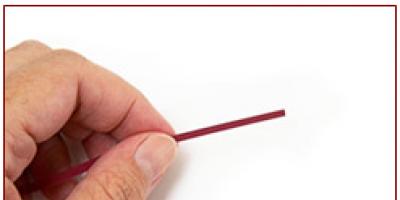Mastic is an extremely convenient material for creating voluminous flowers for decorating cakes and other confectionery products with your own hands. It is convenient because you can use it to make flowers from mastic - flower petals and leaves - of different thicknesses, to imitate the relief, structure, shape and other nuances. There are many ways to create flowers, all of which will help beginners master this difficult at first glance, but very exciting art - creating daisies, orchids, roses and other amazing flowers from mastic.
A master class on decorating cakes with your own hands offers different recipes for mastic: gelatin, from marzipan (almond), regular sugar, from ready-made marshmallows. The choice of the type of material depends on what kind of flower you want to make: marzipan is suitable for creating dense, voluminous flowers; thin openwork petals cannot be obtained from it. Gelatin hardens instantly, and you need to work with it quickly and carefully, but it is quite plastic, takes the shape given in the master class well, and follows the curves. The usual one made from powdered sugar or marshmallow is suitable for voluminous and flat flowers, universal, optimal for a novice pastry chef.

Flowers made from mastic are the most popular decoration for cakes, muffins, and pastries. Roses are a win-win option - they look elegant and unusual, they always add volume to the cake and visually increase it. There are 2 types of roses that you can create with your own hands:
- flat - they are cut out of a layer of mastic, then the contours are drawn on the workpiece with liquid dye and a brush;
- voluminous flowers from mastic - created from many petals of different sizes, placed on the cake using toothpicks or on cream, syrup, confectionery gel.
Step-by-step creation of a rose using video step by step:
- Make mastic, divide into 2 parts, paint in pink and green shades.
- Roll out a layer (no more than 1.5 mm in thickness) of the pink part, cut out ovals of different sizes with a thin knife.
- Place the petal on the mat, use a special stick with a ball at the end to roll out the edges without touching the lower part - it will be adjacent to the core.
- Place all the rolled out petals in a tablespoon so that the edges are slightly curled to create a natural curve.
- Glue one uncurled petal around a toothpick, moistening it with water. We attach the remaining petals - from smallest to largest.
- Using tweezers, bend the petals outward for the mastic flower.
- We cut out the leaves with a special die cutter or knife, also bend the edges, attach them under the bottom of the rose bud and let the whole product dry for 1-2 days.
You can see the exact step-by-step diagram for creating a voluminous mastic rose at . The video shows only the base, but you can increase the number of petals, creating huge voluminous buds, make two-color petals, after drying, decorate the edges of the rose, after moistening them with gel, powder or powder, and generally experiment.
Poppy

Charming mastic flowers - bright red poppies - will become a real decoration for the cake. Although they are voluminous, they have only one row of petals, making them easier to make than the same rose. There are several nuances in creating poppies with your own hands:
- you will need a lot of dye for the color to be rich and bright;
- because of this, the mastic may “float”, so it is better to take a ready-made one in a bright scarlet shade;
- or, alternatively, add powdered sugar at the same time as the dye.
Making poppy seeds on a cake with your own hands is not difficult, but a master class with a video that you will find will help you with this:
- roll out the layer and cut out 4 “hearts” for poppy flowers from mastic;
- make the edges wavy with a spoon or a special tool;
- fold the hearts in the center with a cross and secure with gel;
- so that the edges of the petals are bent upward, dry them on rounded surfaces, for example, shot glasses;
- the poppy core is a flattened ball of black mastic, where the relief can be made with an ordinary grater;
- place a white ball in the center;
on dry petals for mastic flowers, you can draw thin stripes with black paint and shade the edges with a more saturated red or burgundy dye.
Tulips

Why are tulips good for decorating a cake? Diversity. You can make “classic” pink or yellow flowers from mastic, make selected varieties with wavy or torn edges of the petals, black or purple in color, and collect them in bouquets. The video will help you learn how to prepare the base, and then it’s a matter of skill and imagination:
- Spread a layer of mastic on a skewer or toothpick and form a pestle;
- we make flower petals from mastic - oval blanks of the same size (1 mm thick) are processed along the edges with a spoon to make them wavy, dried, and folded inward;
- we collect around the pestle using a special gel;
- We lighten the base of each petal from the outside with dye (powder) using the ombre technique;
- collect several tulips in a bouquet and place them on the cake.
It is convenient to dry tulip buds collected together in a narrow glass. If you need blooming tulips for the cake, just carefully push the petals apart with your hands so that they don’t fall off. It is better to place tulips on the cake using toothpicks, since a liquid coating (not hardened glaze or cream) can ruin all your work and simply soften the buds. You can watch a detailed master class on making charming tulips for decorating a cake in the video.
Daisies

It is easiest to make a bouquet of daisies from mastic; it is with this flower that you can begin your acquaintance with mastic and products made from it, using a master class. This flower is single-layered, almost flat, does not require special ones and is quickly made.
So, creating a chamomile from mastic is very simple:
- roll out a layer of white mastic;
- Use a special cutting tool to make a chamomile;
- Use a knife to press grooves along the petals;
- glue a circle of yellow mastic in the middle, make a relief;
- below, if necessary, attach stems and leaves, like a real chamomile, but from mastic;
- Collect several daisies into a common bouquet or “scatter” them over the cake.
The master class for flowers made from mastic (daisies) is very suitable for beginners; you can find out the details of creating this decor for the cake by going to. This flower is also convenient because it does not need to be attached to stems made of toothpicks or wire - just place the chamomile on the icing or cream on the surface of the cake and press it down a little with your fingers, forming a bouquet.
Orchids

An orchid is an incredibly elegant flower, but the video on how to create it from mastic requires some skill in working with such material, which may not be possible for beginners. In any case, the master class will be useful for both beginners and experienced confectioners.
We make an orchid for a bouquet as follows:
- Using a special cutting tool (as in the video) we make oval petals for a flower from mastic, round the edges, and give them wavy;
- take the wire, attach a ball of mastic to the tip, put on the petal and round it inward;
- we tint the petal for the mastic flower with pink dye using a brush;
- collect the remaining petals on a wire, paint the entire orchid, dry it for about a day, and only after that attach it to the finished cake.
MK will help you correctly arrange the petals and paint them in the right shades, assembling them into a bouquet correctly, but the master class can be supplemented with a photograph of a real orchid if you want to achieve greater realism. Watch the full master class on creating an orchid by.
A master class on decorating a bouquet of mastic flowers is just a guide. You will need pastry tools for mastic flowers - stacks, cutters, knives - and a little patience and dexterity. To create a flower from mastic, the main thing is patience and accuracy.
1. WHAT IS MASTIC. MODELING CRAFTS AND DECORATING CAKES WITH EDIBLE FLOWERS
Recently published materials on our website were devoted to the art of making original flowers from different materials . With the help of video and photo master classes, novice needlewomen made beautiful crafts made from ribbons, fabric, paper, foam, cold porcelain and other popular materials in one technique or another. An article about methods for making “delicious” foods received a particularly wide response. balloons of flowers and bouquets of toys with candies . Such crafts can be given to brides for a wedding, to the mother of a newborn when being discharged from the hospital, or for housewarming.
Handmade gifts have been and will always be highly valued at all times. It is not surprising that homemade bouquets of artificial flowers, panel on the wall or flower toys in the form of animals, many craftswomen make to order, organize their own business... and such gift items are not cheap at all.
Continuing the theme of making edible flowers and bouquets, we have prepared interesting ideas and master classes for you, with the help of which you will learn how to make beautiful flowers with your own hands (roses, peonies, lilies, chrysanthemums ) from mastic for decorating cakes, cupcakes, pies. You can also make it from flower mastic original bouquets for the bride and for friends at the wedding. You will learn how to make homemade mastic for cakes and for decorating various culinary products with flowers and figures.
What is culinary mastic? This is a material convenient for making edible crafts and decorative ornaments, from which you can easily sculpt different shapes (flowers, figurines, children's crafts), quickly hardening and hardening after final processing by hand or with special tools. You don’t have to have culinary skills to learn how to sculpt flowers yourself (using video lessons and photo master classes) from homemade mastic for decorating cakes and other confectionery products. Little girls especially like to help their mothers make interesting flowers from fondant that can be used to decorate a cake for a family holiday. Therefore, be sure to involve your children in this creative work.
√ How to make mastic at home for the base of cakes and for sculpting flowers:
Tools for making homemade mastic.
A dry and clean surface for rolling out the mixture (a wooden board is an excellent option);
Rolling pin (wooden or plastic);
Metal ruler;
A knife with a round cutting surface that rotates on the handle;
Food film;
Ribbon.
Recipes for making homemade mastic for decorating cakes:
There are many different types of mastic and most of the options can be prepared at home with your own hands. But we will focus on several options for mastic - flower and gelatin.
An ideal material for sculpting edible flowers at home. It is easy to cut out flower details from the rolled out mass using a knife and molds. You can quickly make petals and leaves from these blanks , giving them any shape.
Recipe.
Powdered sugar - 250 gr.
Cold water - 40 ml
Gelatin - 2 teaspoons
Liquid glucose - 1 teaspoon
Cooking method.
Pour gelatin into a glass and add water. Stir and wait ten minutes
Dissolve gelatin using a water bath and add glucose to the solution, stir
Add powdered sugar one spoon at a time and stir the mixture each time. There should be a thick consistency
Sprinkle a thin layer of powdered sugar onto a clean surface and lay out the prepared mixture. Stir the mass like dough and gradually add powder. The flower mastic is finally ready when it becomes a little sticky;
Now all that remains is to pack the homemade mastic in a sealed plastic container and put it in the closet for 4-5 hours.
+ gelatin mastic (pastillage).
The main ingredient of this cake decorating material is gelatin. Ideal for sculpting complex-shaped petals and small flower details - pistils, stamens, inflorescences. This is a very plastic mass, easy to sculpt with your hands, which quickly hardens after the craft part takes its final shape.
Recipes for making gelatin, sugar and milk mastic at home:
√ How to make a flower from cake fondant (step by step):
To make a delicious craft, we take marshmallow or gelatin mastic;
Sprinkle the surface with powdered sugar, lay out the mass and roll it out with a rolling pin until the thin mastic is visible;
Using a round knife, we cut out the desired part of the flower according to the template and give it the appropriate shape (petal, leaf, sepal);
We make a bud or an open flower from the petals and attach the remaining elements;
Place each collected flower for the cake in a plastic bag and start working on the next one;
When all the flowers and figures for the cake are made, carefully place them on a curved surface, and then put them in a dry and cool place for several days;
After 2-3 days, you can decorate the cake with hardened flowers and mastic figures.
Children's and wedding cakes made of mastic (photo), decorated with flowers and figures:
√ How to make a mastic cake at home:
Leveling the surface of the cake.
Heat a wide knife or spatula over the burner;
We begin to carefully level the creamy surface of the cake;
The surface should become smooth - without pits and tubercles. The oil will heat up from the heated blade and gradually spread over the surface in an even layer
Forming a layer of mastic on the leveled surface of the cake.
Roll out the mastic for the base with a rolling pin on a clean, flat surface. Go over the rolled out mass with a rolling pin 3-4 times until the consistency becomes homogeneous and not too grainy;
The rolled out mastic should be twice the diameter of the cake in order to completely cover the surface of the product on top and sides;
Holding the rolled out mastic on the rolling pin with your hand, transfer it to the cake, carefully smoothing it with a spatula. But it is best to smooth out a thin layer of mastic using special pastry irons so that it lies evenly, without the formation of air bubbles;
Using a round knife, cut off excess pieces of mastic around the cake.
Decorating a cake with flowers from homemade mastic.
The last, most exciting stage. We take out already hardened flowers from gelatin mastic or from pastillage (marshmallows) from a dry place, and begin to lay out and strengthen these beautiful handmade crafts on the surface of the cake.
2. HOW TO MAKE SIMPLE MASTIC FLOWERS FOR CAKE DECORATION
Materials and tools for sculpting:
- Stacks with rounded, sharp, spatula-shaped and other tip options;
Die-cut molds with thin edges;
Dry food coloring;
Flower (sugar, gelatin, chocolate, milk) mastic.
Large single flowers for cakes are often sculpted using a wire frame. A wire frame is not used to sculpt a complex composition of flowers and figures. You can attach homemade flowers to a birthday cake using a base lined with pastry cream or using a chocolate mixture.
3. MASTER CLASSES ON MAKING BEAUTIFUL FLOWERS FROM HOMEMADE MASTIC
Master class No. 1:
HOW TO MAKE 2 SIMPLE FLOWERS FROM SUGAR MASTIC AT HOME. STEP-BY-STEP PHOTO LESSON.
Master class No. 2:
HOW TO QUICKLY MAKE SMALL FLOWERS FROM MASTIC WITH YOUR OWN HANDS TO FORM A BOUQUET OR COMPOSITION FOR A CONFECTIONERY PRODUCT. PHOTO MK.
Master class No. 3:
WE MAKE CHILDREN'S CAKE FROM SUGAR MASTIC AT HOME. PHOTOS OF THE STEPS OF DESIGNING A TASTY CULINARY PRODUCT IN THE FORM OF A BOUQUET WITH ROSES.
Master class No. 4:
HOW TO MAKE A BEAUTIFUL FLOWER FROM MASTIC WITH YOUR OWN HANDS. PHOTO WITH STEPS OF MODELING PETALS FOR FORMING A PEONY.
Master class No. 5:
WE DECORATE WEDDING CAKES. MOLDING FROM FLOWER MASTIC OF A BEAUTIFUL WHITE ROSE WITH LEAVES - PHOTO OF EACH STAGE OF WORK ON THE CULINARY PRODUCT.
Master class No. 6:
STEP-BY-STEP MASKING FOR BEGINNERS ON MODELING A BEAUTIFUL ROSE FROM FLORAL MASTIC FOR A CAKE. PHOTO AND DESCRIPTION OF EACH STAGE OF MODELING.
Master class No. 7:
HOW TO DO.
Master class No. 8:
On any holiday, at any celebration, even for the most insignificant reason, flowers appear! This could not but affect confectionery products - so bright, elegant flowering cakes burst into our lives, replacing the small standard roses according to GOST.
A cake with flowers is a real work of art. It is endowed with fame and enjoys great popularity. Such decor can be arranged in different order of design:
- Fashionable, modern, in demand, cascade - a tape smoothly descending in a straight or spiral line.
- Elegant interlayer decor along the contour. Elements of different sizes at several levels of the product look modern and unusual.
- Chaotically scattered exotic inflorescences give the dessert a cosmic or fairy-tale look.
- A floral hat for minimalists is decorated exclusively on the top of the product.
In addition to living plants, a flower meadow can be made from confectionery materials. Which ones exactly we will figure out.
Cakes with cream flowers

Opinions are mixed about which cream is more convenient to make decor from. Everyone chooses their own “favorite”. The most popular among confectioners are Charlotte cream and milk-butter cream. Both of them are good, and both provide excellent results while providing ease of use.
Milk-butter cream
Ingredients
- Milk (cold) - 80 gr.
- Butter (cold) - 225 gr.
- Powdered sugar - 90 gr.
Cooking method
- Pour powder into cold milk and stir.
- Cut the butter into small cubes and place in a mixing bowl with a mixer.
We begin to beat at low speed, introducing milk in a thin stream. - Increase the speed to high and beat until a homogeneous, smooth texture is obtained (about 15 minutes).
- Divide the mass into parts if you need to get several colors, and paint each part in a separate bowl.
- We transfer it into a pastry bag with the necessary nozzle, and begin the creative process - forming roses.
Cream Charlotte
Ingredients
- Butter - 300 gr.
- Egg - 1 pc.
- Egg yolk - 1 pc.
- Sugar - 200 gr.
- Milk - 180 gr.
Cooking method
- Combine milk with sugar in a saucepan with a thick bottom. Place on low heat until the milk warms up and all the sugar dissolves. There is no need to bring to a boil.
- Beat the egg and yolk into a fluffy foam. Add vanilla.
- With the mixer running (at minimum speed), add the milk syrup in a thin stream.
- Pour the mixture back into the pan and put it on the fire again to obtain a thicker consistency.
- After the mixture has thickened a little, remove from heat, transfer to a clean container, cover with film and leave to cool.
- Beat softened butter (room temperature) with a mixer. This process will take you about 7 minutes.
- Add the custard base in small portions, beating well each time with a mixer.
- Add coloring with the last portion.
Flower cakes with mastic elements
Mastic for confectioners is just a godsend. You can use it to make incredibly realistic and mesmerizing beautiful decorative elements. We looked at how to make mastic in. You can watch a detailed master class on making roses from it in the video.
A flower cake is a magnificent spectacle, exquisite, bringing celebration. Additionally, you can decorate with mother-of-pearl sprinkles, beautiful butterflies made of marzipan, elegant dragonflies or cute ladybugs made of icing.
A fashion trend this year was the appearance of 3D flower cakes. They represent the image of a real bouquet. This is a new word in culinary art, which barely resembles a traditional delicacy.
The ability to beautifully decorate a cake is an art, and decorating it with edible flowers that inspire poetry rather than tea drinking is the height of skill.
Confectionery products should not only be tasty, but also aesthetically attractive. Professionals use special mastic to decorate sweet products, from which they create beads, flowers, letters or garlands. You can create this kind of cake elements yourself. For example, making flowers from mastic with your own hands, following the classic recipe step by step, can be made even by those who rarely deal with making sweets.
What is confectionery mastic made from?
Decorating mastic is a plastic paste made from powdered sugar, potato starch, crushed almonds with sugar, egg white, gelatin powder or marshmallows. But if sugar is a mandatory ingredient, then the rest are added depending on the type of mastic. This plasticine-shaped decoration first appeared in the 16th century. However, at that time, mastic was used as a raw material for candies. And only in the 20th century they began to make original sweet decorations from it. Due to the fact that mastic is very plastic, it can be used to make any decoration elements for confectionery products.
Types of mastic
Confectionery mastic differs in composition and, accordingly, in types:

How to choose mastic
The choice of mastic type depends on 2 factors:
- your level of proficiency in creating jewelry from mastic;
- elements that you are going to make from this material.
As for the first condition, of course, for beginners it is better to start with universal, industrial mastic. After all, it is suitable for any finishing details: both for fitting and for creating three-dimensional elements.
If you already have some skills in working with mastic, then decide on the parts that you plan to make from it and select the most suitable type. However, remember that if you are planning to make a cake with flowers from fondant, it is better to choose a floral one. You can also use it to cover the cakes.
Tools for working with mastic
To facilitate and simplify the process of sculpting decorations from mastic, special tools are used to work with this confectionery material:

Homemade mastic recipe
If you want to do all the stages of preparing and decorating the cake yourself, then you can’t do without a mastic recipe.
Ingredients:
- 2 tsp. gelatin (or 200 g of white marshmallows);
- 500 g sugar (preferably powder);
- ¼ glass of water.
Preparation:

The marshmallow recipe does not use gelatin. The marshmallow thickener is pre-melted with water - the mastic turns out softer. The material for confectionery finishing should be stored in the refrigerator.
How to make roses from mastic

Flowers are rightfully considered the most festive, elegant elements of cake design, among which roses occupy a special place. A variety of shapes and shades allows you to create original, luxurious compositions. The master class will help you make such flowers from mastic.
Ingredients:
- pink mastic;
- powdered sugar;
- silicone mat;
- cutting and modeling sticks;
- washcloth;
- rolling pin;
- water;
- paint brush;
- toothpick;
- a few dessert spoons.
Preparation:

How to create lilies from mastic
No less interesting are cakes decorated with lilies made from pastry fondant.

Ingredients:
- mastic;
- sugar;
- water;
- paint brush;
- rolling pin;
- felling;
- modeling sticks;
- toothpicks.
Preparation:
- Squeeze lily petals onto a rolled out layer of mastic.
- Using a stick, we make a ruffle-like edging for each petal. We lay out the workpieces to dry.
- We wrap a piece of mastic around a toothpick - this is the pistil of a lily.
- Using the same pattern, we make stamens.
- We connect the parts of the flower, wetting the contact areas with water.
- Leave the finished mastic lily to dry for 2-3 hours.
Secrets of working with mastic




If you decide to decorate a confectionery product with figures from homemade mastic, then it will be useful to learn some tricks of working with this material. Knowing the nuances, you will make a cake with mastic flowers that you can rightfully be proud of.
- If you are preparing colored mastic, add the food coloring while mixing the ingredients, otherwise you won’t get a uniform color.
- Beetroot or carrot juice works well as a dye.
- The mastic is stored for about 3 months, but at a temperature of 10 to 20 degrees.
- To make it easier to roll out the mastic into a layer, you can heat it up a little.
- Three-dimensional figures stand more firmly on a base of thick cream or marzipan.
Any confectionery product, especially cakes, looks better with unusual decorations. Therefore, you can make flowers from mastic with your own hands, following the instructions step by step. This edible design will add even more brightness to any holiday and make it memorable for both children and adults.
by the materials LadySpecial.ru
2015-10-31T16:01:07+00:00 admin useful tips desserts, useful tips, secrets from the chefConfectionery products should not only be tasty, but also aesthetically attractive. Professionals use special mastic to decorate sweet products, from which they create beads, flowers, letters or garlands. You can create this kind of cake elements yourself. For example, you can make flowers from mastic with your own hands, following the classic recipe step by step...
[email protected] Administrator Feast-onlineRelated Tagged Posts

Sometimes you want to surprise your loved one by making your evening together unforgettable. A romantic dinner is ideal for this. It is important to remember that dishes for him should be simple, tasty and quick to prepare. IN...
If everyone knows about the benefits of oatmeal, then the oatmeal diet should be one of the healthiest. For many of us, oatmeal is associated with a healthy diet, and for good reason, but...
Nowadays there are a huge variety of ways to decorate cakes; sprinkles, chocolate painting, cream, and mastic will come to your aid here. The latter provides the finished cake with the most neat and impressive appearance. If you have never worked with this material before, but your hands have been itching to try for a long time, start with simple and popular decorative elements, such as flowers. And now we will tell you how to do this in the easiest way.
Simple flowers made from mastic with your own hands - master class for beginners
For such a simple chamomile, we need yellow mastic for the middle and blue or any light one for the petals. As well as a ruler, a knife, a wine or champagne cork, a pipe of a suitable diameter and a bowl of a suitable size.

For the petals, roll out the mastic into plastic and cut it into long narrow strips. We bend each strip around the tube and connect it. The size of the petals will depend on the diameter of the tube, but it is important that after connecting the strips there is not a very short edge left.

In this position, let them dry a little and fix their shape, and then they can be transferred for final drying, for example, into cut plastic bottles or a large tray.

The result is identical petal rings.

Now from the yellow mastic we cut out the cores that are suitable in size for the petals. The relief on them can be made with a toothpick or by imprinting through gauze.

Now we take the cork, place the core face down on it and begin to collect the flower on top of it. Now you can see how much edge you need to leave, and how much you can simply cut off, giving the tip a cone shape. We seal with plain water.

When the petals are collected, we place another core on top, so the flower will turn out to be double-sided.
If suddenly it happens that your mastic does not harden or does not hold its shape, do not be upset. The flower can be made not so voluminous, but very pretty.

How to make small flowers from mastic without special tools?
We will need one color of mastic, a pencil, scissors, a toothpick and a pen with a rounded cap or something like a drumstick.
First, roll a small ball out of mastic, then give it the shape of a drop.
Then we spray the pointed side of the pencil with starch so that it does not stick and insert the blank with the blunt side, pushing the pencil quite deep inside.

We take out a pencil and carefully make six cuts with scissors, trying to ensure that the petals are the same size.
Now we flatten each petal with our fingers, make the edges oval and bend it outward.

Let's make the edges of the petals even thinner to give the flower elegance.
At this stage, you can bend the petals overlapping each other, tint the middle and get a plumeria.

Or you can continue working, using a toothpick we make a relief on the petals, alternating three, bend them a little towards the center, and leave three straightened. We insert the stamens and get a freesia bud. You can leave it open, or you can leave it unblown, then the stamens will not be needed. It is better to dry such a flower in a suspended state, upside down.








